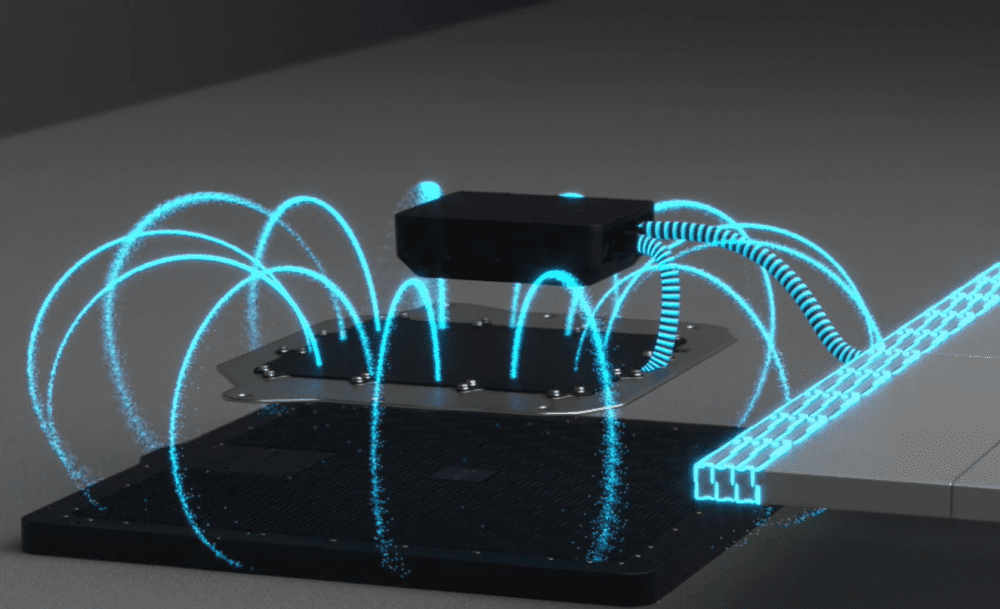Can my EV be cable free ?
Many of us are familiar with electrical current induction when we charge our phones on a wireless charging pad. The technology relies on the phenomena of charging a coil of wire with alternating current, producing a magnetic field. An uncharged coil of wire entering that magnetic field will induce an electric current in the uncharged coil. This was discovered and demonstrated by Nicola Tesla back in 1891. As we know from charging our phones, the 2 coils need to be close together because the natural magnetic field produced by the inducing coil radiates in all directions and its energy diminishes very rapidly over distance – this is exactly why the induction coils needs to be very close together. We lay our phones directly on the charging pad, ensuring that the coil in the pad and the coil in the phone are very close to each other. Induction also demands that the coils be aligned with each other, which is why our phones need to be carefully aligned on the charging pad in order for wireless charging to work. We also note that induction produces heat, and that part of the phenomena is being used effectively in producing induction cook tops, which require magnetic cookware.
So, can the magic of induction be improved and scaled up to a point where the battery of an electric vehicle (EV) can be charged wirelessly? The answer is turning out to be yes. Researchers have been able to modify the natural shape of the magnetic field produced by the primary (inducer) coil and focus that magnetic field directly on the secondary (induction) coil. The key to achieving this is to precisely match the magnetic resonance of the 2 coils, altering resistance, inductance, and distributed capacitance. The result is that the magnetic field is more like a tunnel, focusing its energy on the secondary coil and producing a much stronger coupling of the 2 coils. It also turns out that this design does not require precise alignment of the coils. Given this research, developers of EV chargers may now have a technology that can be ramped up and not require perfect vehicle parking to achieve a workable alignment of the charging coils. This could also be the technology to enable charging vehicles on the move.

The race is now on to bring commercially viable wireless charging to the EV marketplace:
- Research is being conducted at the Oak Ridge National Laboratory in Tennessee, where they have developed a polyphase electromagnetic coil. They have recently licensed the technology to HEVO in Brooklyn New York, whose CEO claims that their hands-free charger has a surface power density of 1.5 megawatts per square metre, enabling very fast charging speed. HEVO envisions charging while driving on specially modified roads, even while driving at highway speeds. This will require the installation of a device on the underside of the vehicle, about the size of a pizza box, and it can operate with grid-to-battery efficiency of 90 to 96.5 %. The charging level can be up to 300 kW, which could facilitate powering a house through a vehicle-to-grid interface.
- WITRICITY has been developing magnetic resonance technology for a few years and have an interoperable standard and supporting infrastructure that could be used by any EV manufacturer. There is now an industry standard for the technology used by WITRICITY (SAE j2954). Their devices work in adverse conditions, like ice and snow, and can transmit through obstacles like asphalt and paving stones, with grid to battery efficiency levels between 90 and 93%. WITRICITY sees great potential for autonomous EV’s providing driverless taxi service, running in dedicated bus and taxi lanes with embedded wireless chargers. These vehicles could be “snacking” on power when travelling in these dedicated lanes or “feasting” while at rest in a taxi queue fitted with embedded chargers. There may be no need to ever charge up the EV battery as a separate operation.
- WAVE (Wireless Advanced Vehicle Electrification) is focused on extreme fast charging for the medium to heavy duty EV market sector, providing embedded chargers producing charging speeds of up to 1 megawatt. They are partnering with TESLA to provide wireless charging technology for the as yet unreleased range of TESLA semi trucks, leading to the construction of wireless charging highways wherever these trucks need to go.
So yes, your EV can be cable free, as there are vehicles on the way to provide it, such as the Genesis GV60 out of South Korea, and there should be choices for retrofitting current EV’s for wireless charging capability. The technology is here and availability is just around the corner.
The goal of TREND DISRUPTORS is to discover and monitor technical developments that have the potential to DISRUPT a market sector. We look for the best ideas, so that we can generate actionable investment recommendations for subscribers. As a general rule, our recommendations in this sector are speculative, and we advise caution, discretion, and thorough research. We strive to identify investment opportunities that can lead to success for the well informed investor.
Stay tuned!
